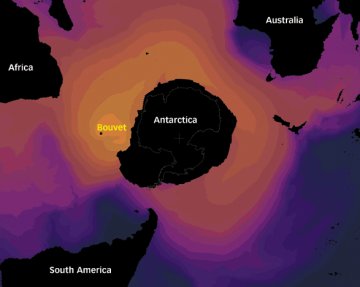Plants travel wind highways
Some plants can hitchhike along invisible freeways of wind to reach distant places.
By Emily Sohn
Gusts of wind can knock you over if they blow hard enough. If you were a plant, though, the wind could carry you or your spores for thousands of kilometers.
A NASA satellite called QuikSCAT has revealed highways of wind over Earth’s oceans. Now, scientists from Spain say these invisible roads may explain why many nonflowering plants, such as mosses and lichens, grow where they do.
 |
|
Colors show how winds connect Bouvet Island near Antarctica to neighboring locations. Winds easily give hitchhiking plant snippets a lift from the island to areas in the brightest peach zone. But winds are less and less likely to carry plant material to the areas with progressively darker colors. |
| Ángel M. Felicísimo |
The scientists used data from QuikSCAT for a group of islands in the Southern Hemisphere, near Antarctica. The satellite carries a piece of equipment that sends microwaves from space to the surface of the ocean. The pattern that bounces back reveals which way the winds are blowing. Winds tend to blow counterclockwise around Antarctica, but there are lots of shifts and spirals thrown in.
When the researchers compared these wind patterns to botanical data, they found that the wind had an important effect on where species of mosses, lichens, and other nonflowering plant species grow.
For example, Bouvet Island and Heard Island share 30 percent of their moss species, 29 percent of liverworts, and 32 percent of lichens—even though the islands are 4,430 kilometers apart. In contrast, Gough Island and Bouvet Island, which are just 1,860 kilometers apart, share only 16 percent of mosses and 17 percent of liverworts, and they have no lichens in common.
Ferns and flowering plants don’t travel as well in the wind, so they don’t show the same kinds of distribution patterns.
Where do you think you would end up if you could ride the wind?







